
We all know that studying in the US is expensive for many students, but the fact is that even applying in the US can cost a lot of money regardless of whether you’re planning to pursue a Bachelor’s/Master’s/ PhD or MBA Program.
Today, I will show you the reality of applying to universities and colleges in the US by breaking down exactly how much money I spent during the complete US College Application Process, from buying preparation material for the standardized tests to paying the report-sending fees for the financial aid applications. Not just that, I’ll also show you how I saved more than a thousand dollars during the whole process and how you can do the same when you apply.
If you’re planning to apply in the US, do read this post till the end, as you’ll get
✅ A complete overview of the different types of application expenses.
✅ How much money each expense would cost you.
✅ The approximate amount you’d be spending by the end of your application journey.
Applying Isn’t Free
When people say that you can win 100% scholarships to study abroad or get full financial aid at a top US university, they often ignore or fail to inform you about the actual costs of the application process. That’s why many students have no idea about what it takes mentally and financially to apply for competitive opportunities, especially at US institutions. I was once at your place and assumed that it wouldn’t take much, in terms of money, to apply to top universities in the US.
But I was wrong ❌
Like many students, I didn’t know that before being able to complete my application and apply for different opportunities, I need to be ready to incur various costs, including exam registration fees, purchases of preparation resources, coaching payment, application fees, score sending fees and more. Yes, it is possible to study for free at different universities if you get a full scholarship or financial aid, but you can’t apply entirely for free.
While some costs such as the application fee and financial aid fee can be waived off in the US College Application Process depending on your financial condition, not all costs can be eliminated, esp. if you are an international student 😣
Before we dive into our first expense, let me tell you that I applied to top US Universities for the fall of 2021 as an Indian International Student. Whatever expenses I’m going to share are the expenses I had to bear based on my unique background and situation. The amount of money you’ll be paying during the application process will differ and depend on your background, financial condition, application cycle, number of applications, country of residence, and other factors.
Hence, take my expenses data as a rough guide, not as a 100% accurate depiction of what students pay during the US College Application Process 🤷♂️
I suggest you create your application expenses list as you read this post to see how much your college application journey would likely cost you. If you want, you can comment below on how many universities you’re planning to target this year and how much money you’re expecting to pay. It’d be interesting to see how much the cost for the same process varies for different students.
Also, if you’re someone like me who prefers visual graphics and video over plane images and text, do consider watching my video on the same topic, US College Application Expenses, down below 👇 It’s a long one, but worth every minute.
Standardized Tests Registration Fees
The first direct cost you’d be having in your college application process is the registration fee for the standardized tests. Even though many US Universities have gone test-optional with the SAT and ACT, which means it’s up to you whether or not you want to send your SAT and ACT scores to a school, there are a couple of universities that may still require the Standardized Test scores.
If you decide not to take any of the standardized tests for your college applications based on the requirements of your colleges, you won’t have to worry about the registration fees for the standardized tests 🛌
However, if you’re keeping your options open and want to make your profile competitive for admission into top US Universities, you would’ve definitely decided to take a Standardized Test, either SAT, ACT, or both. In my view, I would recommend every student, especially international students, to take a Standardized Test because a good score helps your application and every possible chance of standing out from the crowd in a competitive application pool is worth taking.
So once you make up your mind to take a standardized test for your applications, your first expense would be the registration fees for the SAT, ACT, or both, and this would vary depending on the test you’re taking and the number of times you’d be taking it ✍
As for me, I took the SAT without the Essay only once on 7th December 2019 and registered for it on 27th September 2019. The registration for the SAT cost me US$98.5, approximately equal to 7700 Indian Rupees based on the current exchange rate.
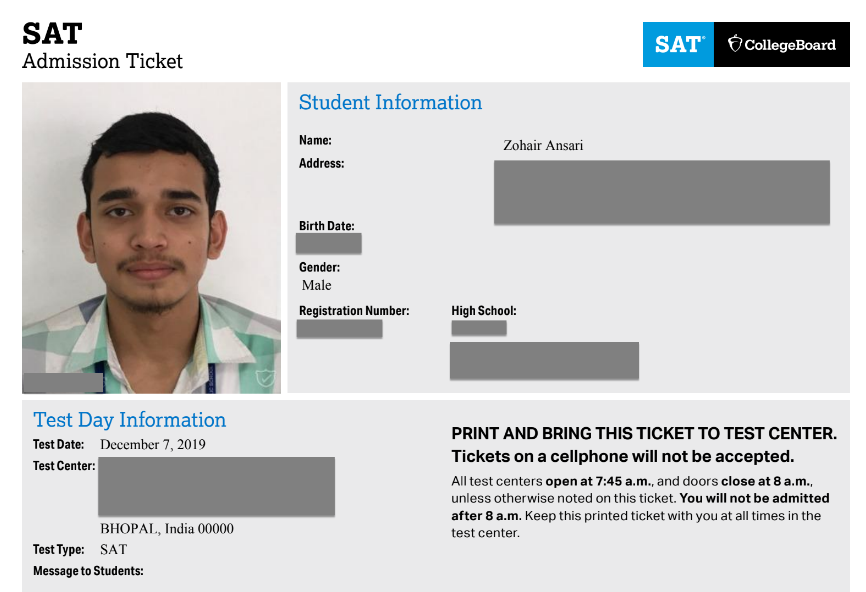
Here is the Email Confirmation for the payment of my ‘SAT without Essay’ Exam:
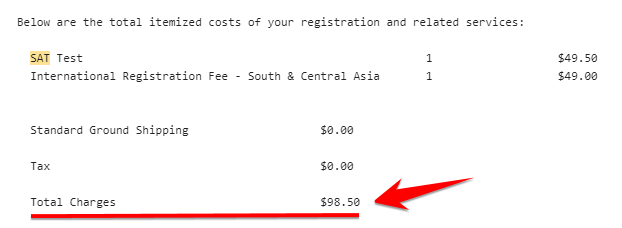
Additionally, I took two SAT Subject Tests, one in Mathematics Level 2 and the second in Physics. I registered for the Subject Tests the same day I registered for the SAT General: 27th September 2019, and both the Subject tests took place a month before the SAT General, on 2nd November 2019.
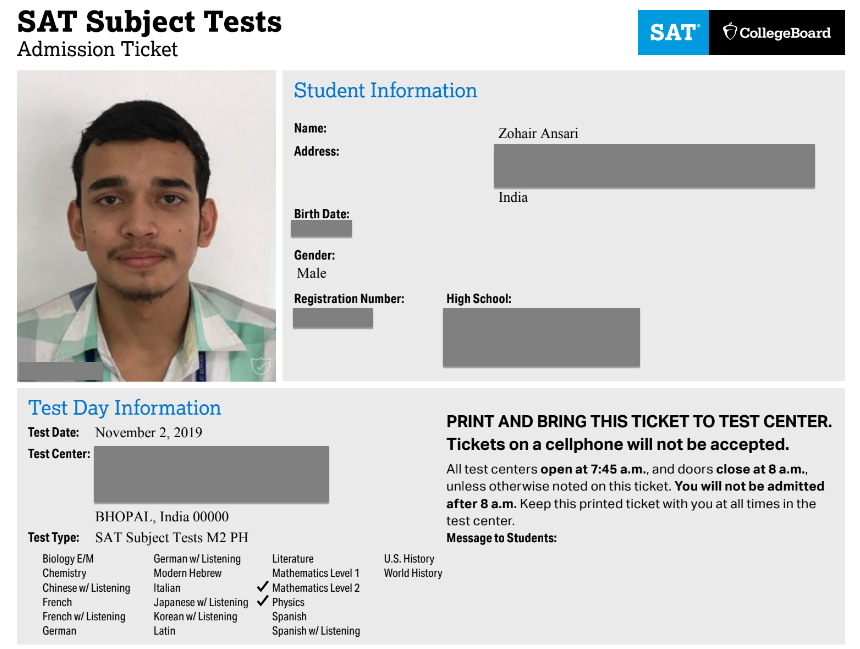
The two subject tests cost me US$119 or ~₹9300. But, of course, those were pre-pandemic times and SAT subject tests were a part of the admission process, so I had to worry about their expense. Now, the good news is that you don’t have to worry about it as SAT Subject tests no longer happen. College Board discontinued all the SAT Subject Tests a long time ago, in January 2021, to reduce the college application demands on students.
Moreover, they also discontinued the SAT with Essay, so you don’t have to worry about that too. Currently, the SAT without essay exists, and the ACT with and without the essay exists.
My total expense from the Standardized tests was $217.5 or ~ ₹17,000. Yours will be much less since you won’t have to take the SAT Subject Tests. Also, remember that the registration charges for these tests will differ for you as they vary from country to country and change over time. They have changed in India since I appeared for the examination in 2019 and may have changed in other countries as well, so do refer to the official websites of ACT and the College Board for the current pricing of the tests ok
Now, you might be wondering if it’s possible to get a fee waiver for the registration fees of the standardized tests.
The answer depends on where you’re coming from.
If you are a low-income 11th or 12th-grade student residing in the U.S. or U.S. territories, you can get the ACT Fee Waiver and College Board’s Official SAT Fee Waiver. Both come along with other benefits such as free learning resources, the ability to send your test scores to multiple universities free of charge, etc.
If get any of the fee waivers, you won’t be required to pay a single cent for the registration of these tests. However, this is only true for low-income students in the U.S. who meet specific eligibility criteria set by the College Board and the ACT. In case you need more details, check out the links to the official fee waiver pages below.
👉 SAT Fee Waiver Eligibility Criteria
👉 ACT Fee Waiver Eligibility Criteria
But what about people residing in places other than the U.S. states and territories?
As of now, only U.S. Citizens in other countries can get the official fee waivers. So if you are living in a foreign nation and applying as an international student, unfortunately, you are not eligible to apply for them 😥
However, some third-party organizations in different countries do offer SAT fee waivers from their end. In India, a scholarship platform named Buddy4Study has partnered with the College Board to offer 90% and 50% SAT fee waivers to low-income Indian students in Grade 11th and 12th.
Officially, it’s called the College Board India Scholars Program. It also comes with some cool benefits like 100% tuition scholarships at some of the best Indian Universities for students who score above 1300 on the SAT. Cool, isn’t it?
Soon, I’ll be writing a detailed article on this program, but for now, you can check out the link to the scholarship program below if you’re interested in learning more about it.
👉 College Board India Scholars Program
So, if you get this scholarship from College Board or any other ‘unofficial’ fee waiver, you can substantially decrease your registration charges for the SAT.
Standardized Tests Preparation Resources
Once you register for any standardized tests, be it the SAT or the ACT, you must have a solid preparation plan. Preparation can happen for free by getting books issued from your school library, using free online resources like Khan Academy, or through paid practice material in the form of books or online programs. Some students get high scores using only free practice material on Khan Academy, whereas others achieve equally good scores using prep books 📚
Everybody is different, and what works for someone may or may not work for others because each person’s plan of preparation depends on their current abilities, learning style, amount of time they have, and how much they’re willing to spend on the preparation. If you have a tight budget or are already scoring well, you might want to go ahead with preparation using free resources, and that’s great.
But if you’re someone like me who wants to study everything, including topics, questions, tips, and strategies, and doesn’t want to miss out on anything, you might want to spend some money on prep books, and that’s amazing too 👍
I started my SAT General exam preparation in the middle of my senior year of high school, and for the most part, I prepared online using Khan Academy’s free SAT resources. Later, I found the PDFs (soft copies) of some SAT books and the official practice tests on Google and included them in my preparation. However, I faced various problems using online material.
For example, I couldn’t write on a soft copy the way I could scribble on a hard copy, and I couldn’t practice the official SAT practice tests, emulating the exam conditions, because the practice tests were on the computer, but the test doesn’t happen on a screen. Rather, it happens on paper ✍
Therefore, I decided to get the printouts of all the College Board’s Official Practice Tests for SAT except the first practice test, which I had already attempted online. At that time, there were eight official practice tests, but now College Board has added two more practice tests on their website, which means there are a total of ten official practice tests that you can download for free from the College Board’s website.
👉 Download the Offical SAT Practice Tests
Note: College Board has removed Practice Tests 2 and 4 from their website, but if you search them on Google you’ll find their soft copies (PDFs) as well. Good Luck.
By the way, it’s completely legal to print the SAT’s Official practice tests for Personal Use, not for commercial use. Remember, only for your personal use. No buying or selling here.
I got the hard copy of the Official Practice Tests, and I didn’t have to pay for it because my School’s Principal was kind enough to approve my request to get the printout from the school’s resource room. I requested the printed copy on 24th September 2019, and it took a while for them to compile the papers since there were 464 pages in total.
Four days later, on 28th September 2019, I got all the practice papers neatly bound and collected in the form of a thick book. If my School Principal hadn’t approved this, it would’ve cost me around ₹500 for the hard copy.
Besides Khan Academy and the official practice tests, I didn’t use anything else for my SAT Exam Preparation because I didn’t think it was necessary. That was a mistake. Let’s not get into that. It’s a story for some other time 😌
As for my SAT Subject test preparation, my school teacher told me that the school curriculum, IB Physics HL and Maths HL, would be sufficient for the tests, and I wouldn’t need any extra preparation for those exams.
However, after looking at a few practice tests and watching YouTube videos on the SAT Subject Tests, I noticed a disparity between the IB’s syllabus and the topics covered in the SAT Math and Physics tests 🤦♂️
So, I decided to buy SAT Subject tests books for both the tests as they had all the up-to-date practice tests, tips, strategies, and topic explanations in one place, and I wouldn’t have to constantly juggle between what’s there and what’s not there in my Grade 12th syllabus and the Subject Test contents.
I wanted to purchase all the books that students recommended online, but neither did I have the money to buy them nor the time to go through them. So, I zeroed down to four books:
- SAT Subject Test: Math Level 2 with Online Tests (Barron’s Test Prep)
- SAT Subject Test Physics with Online Test (Barron’s Test Prep)
- The Official SAT Subject Test in Mathematics Level 2 Study Guide (The College Board)
- The Official SAT Subject Test in Physics Study Guide (The College Board)
By the way, none of these is an affiliate link. Just letting you know about my experience. I ain’t making money recommending these 😅
The four books cost ₹4676 at that time, but before buying them, I searched the school library for SAT preparation books. There were many of them: all old ones and no latest versions. So, I thought of an idea.
On 24th September 2019, I sent an email to my School Principal. In it, I talked about my SAT Exam preparation and mentioned how the latest SAT books would help me and help the school’s upcoming classes. He reviewed my request and approved it.
On 14th October 2019, the books arrived at the school, and I immediately got them issued in my name from the school library.
If you’re curious, here is the email I sent him:
Dear Sir,
As you know I am planning to apply to the ivy leagues in December 2019 and will be giving my SAT Subject Tests (2nd November 2019) and SAT General (7th December 2019) before the final deadline of the universities. I have been practicing as much as possible for the SAT General using free resources online. However, there are no quality resources (available for free) for SAT Subject Tests that offer exam-centered study. I did check the library to find resources that can help me and I found a few, but they were not efficient due to the syllabus changes in recent years.
After doing an extensive research online, I found that some resources (mentioned below) are of high-quality and are valid for the upcoming years as well. If we get the books, not only will I benefit from them but it would greatly help the upcoming batch (in which, X and Y are planning to give the SAT Subject Tests). I would also be grateful if we can get them as early as possible because only a month is left to prepare and these tests are decisive for my ivy league applications.
SAT Math Level 2 (Official Guide)
Link
INR 599/-
SAT Math Level 2 (Barron’s)
Link
₹1680/-SAT Physics (Official Guide)
Link
₹1056/-SAT Physics (Barron)
Link
₹1341/-Total- ₹4676/-
Thank You,
Regards,
Md. Zohair Ansari
By the way, my School Principal was quite supportive. Some schools don’t support your goals much, so you need to request things accordingly.
Basically, I would have spend ₹4676 or ~$60 on SAT Subject Tests books if my School Principal hadn’t approved the request. As of now, SAT Subject tests do not exist, so you don’t need to worry about buying prep books for them.
Also, I didn’t buy any books for the SAT General, but you can decide whether or not you want to buy them according to your specific situation. If you do decide to buy them, it would likely be your second expense in the US College Application Process ✌
English Proficiency Test Registration Fees
Moving on to the third expense of the application process and this expense will only apply to non-native English speakers who want to study in the United States. It is the registration fee for an English Language Proficiency Test.
The majority of the universities in the United States and other English-speaking countries require students to take an English Language Test like IELTS, TOEFL, Duolingo English Test, etc. to prove that they have sufficient command over the English Language; however, some institutions will not require you to do so, or they might exempt you from the English requirement because of your background or high school curriculum. For instance, I got my English Proficiency requirement exempted by several US universities because I scored a 7 in the IB English B HL.
But that’s not the whole picture. Whether your universities require or don’t require you to take an English Language Proficiency Test, the US Immigration officer (who gives the final approval for your study through the Student VISA) will unconditionally require you to prove your English Proficiency through either the IELTS Exam or the TOEFL Test (these are two major English tests that are internationally recognized and accepted).
Even though many US institutions accept the Duolingo English Test for their English Requirement, currently, no online English test is accepted by the US Immigration department for the study VISA. So like it or not, as a non-native English speaker, you’ll need to take one or the other English test to prove your proficiency in the language. To do that, you’ll need to first register for the test, which will cost you a few hundred bucks.
That doesn’t sound much, but you’ll know how much money that is in a minute.
Again, I took my IELTS exam in the senior year of my high school on 14th December 2019, which was within a week after my SAT. I registered for the IELTS Exam on 14th November 2019. At that time, registering for the test cost ₹13,250 or ~$170 (according to the current exchange rates).
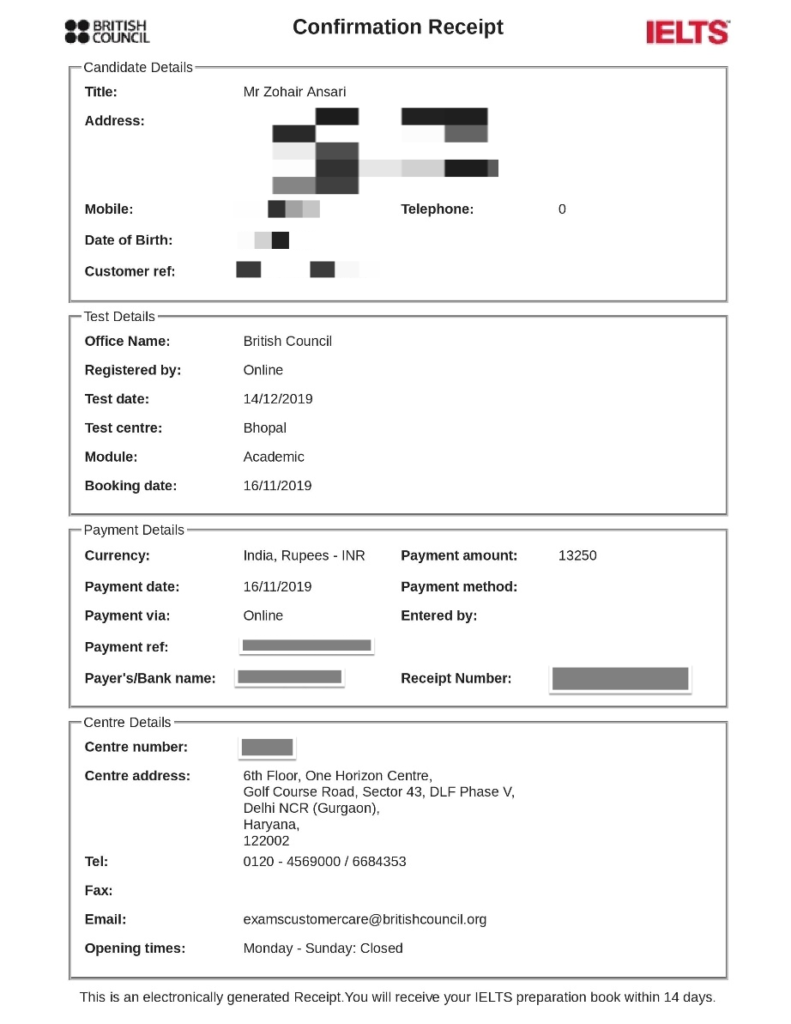
If this looks expensive, you won’t love to hear that the registration charges for the IELTS test in India have increased to ₹15,500 or ~$198. That’s an increase of ₹2,250 (or ~$29) within two years. I don’t know if that’s justified, but this is the reality. You have to pay this much if you plan to take your IELTS test in India 🤷♂️
I didn’t have to take the TOEFL Exam, but I know that TOEFL’s examination fee (compared with IELTS) is more or less the same. And like the SAT, the pricing for these international English tests also varies depending on your location. Currently, it ranges from $150 to $250 (~₹12,000 to ~₹20,000).
Therefore, check the registration fee for these tests in your country when creating your College Expenses List.
Unfortunately, neither IELTS nor TOEFL provides official fee waivers to waive the examination fees for international students in need. So, consider this a mandatory expense in the US College Application Process if you are a non-native English speaker.
Coaching Classes
Many people in the west do not know that many non-native English speakers in India take coaching classes to prepare for their IELTS and TOEFL exams. According to Tribune India, just in the Indian state of Punjab, the number of institutes offering IELTS coaching have increased almost five times in the past five years. The craze of IELTS coaching classes and the surge of IELTS coaching institutes is unprecedented all over India.
But this is not it, these IELTS centers charge between ₹2,000 and ₹20,000 per month for their IELTS classes, and a student, on average, takes two months of IELTS classes for their preparation. Of course, all of this is also true for the TOEFL exam prep, and this scene is taking place in almost all South Asian countries.
But is it worth spending thousands of Rupees for coaching classes on top of spending thousands of Rupees for the registration of these exams?
The answer is YES and NO.
Coaching classes help many students who lack foundational skills in the English language and need one-on-one guidance to tackle their problems. I think coaching classes are especially useful for the Writing and Speaking sections of these English tests as you can get personalized feedback from the instructors on your weaknesses and how you can improve on them for the test 🚀
And since it is so expensive to register for these tests, many students think it would be better to take expensive coaching classes instead of failing and registering for the test again, which would cost a lot of money, and that’s a valid argument.
On a side note, if you plan to take coaching classes. I have a small suggestion for you: before you put your money into a coaching institute, take a few demo classes to decide whether it’s worth it for you or not. Then accordingly, make your final decision. You’ll thank me later 😉
On the other hand, if you are a student with a good foundation in the English language and don’t face many problems with English communication (reading, writing, listening, and speaking), you don’t need to go to coaching classes for your IELTS or TOEFL exam preparation. There is a ton of free practice material available on the internet, which you can use for practice.
Remember that coaching classes don’t invent new stuff; most of the time, they provide the same practice material available online in a more organized format.
Also, if you have time and are willing to spend a few dollars, you can consider buying preparation material for your test prep. Personally, for my IELTS exam study, I found books published by Cambridge to be the most helpful: Cambridge IELTS 14, Cambridge IELTS 15, and Cambridge IELTS 16.
I’m telling you this to reiterate that preparation depends on our current abilities, learning style, time frame, and budget. For example, I might be comfortable with self-studying using books, another person might join a coaching institute for their prep, a third person might see this as unnecessary, and an online prep course might suffice their need.
Maybe you have good English skills, and free material is sufficient for you to prep for IELTS, but you don’t have good math skills and need personalized help and support in the form of coaching to prepare for the SAT. Again, each person is different and will have a different preparation plan.
I don’t have anything against coaching classes, but I have a problem with this popular trend of joining coaching classes because it also lures students who don’t need them. So many students spend their valuable time and money on coaching classes even though they are completely unnecessary for them because this trend of getting coaching for IELTS and TOEFL has created social pressure. So if you haven’t joined these classes, you feel like missing out on essential things.
Some students even feel they can’t do well on the test without taking these classes.
What’s worse? Many middle-income and low-income students are going out of their way to pay for these classes. I am saying this because I’ve experienced this first hand when I decided to go with the trend.
I had a couple of coaching centers for IELTS and SAT Preparation in my city. However, SAT coaching was costly for me then; it was ₹25,000 or ~$320. Hence, taking coaching for the SAT was instantly out of the question. But a friend of mine took the IELTS Coaching classes at a local coaching center, and I felt the pressure that maybe I missed out on many things necessary for the IELTS test.
I did not take the time to make myself aware of the test format and thought that the coaching center had all the answers as well as various secret tips and tricks that would surely help me ace the exam 🤦♂️
Within a few days, I decided to enroll at the IELTS coaching center and paid ₹6500 or ~$83 for the IELTS Classes. See image below 👇
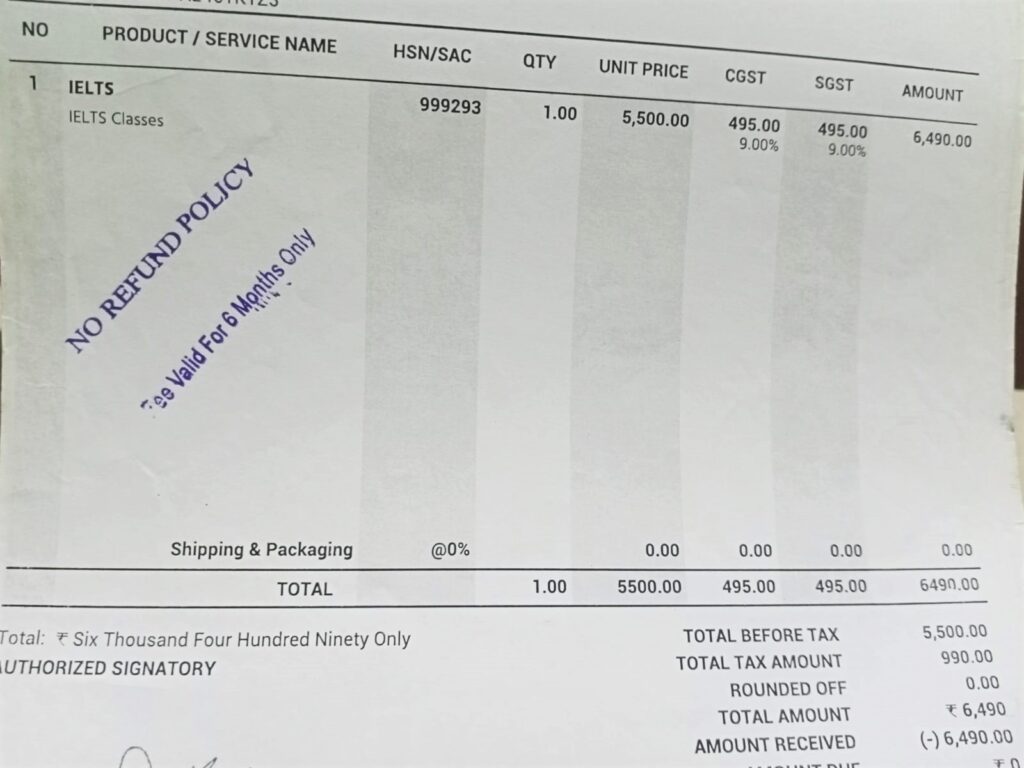
I think the classes were worth it for my friend, but they weren’t worth it for me because
- They were too expensive compared to the mentorship that they offered.
- I didn’t need IELTS Coaching at my level of English proficiency, as IB English classes and SAT preparation material were enough to cover most of the skills tested on the IELTS test, except for English speaking skills, which I practiced daily in school as part of the student council.
I wasn’t fully aware of these things then, which led to the cost.
One of the lessons you can extrapolate for yourself here is to become aware of the application process beforehand as much as possible in terms of what options you have, what to expect from things in the process etc. I hope this post is somewhat helping you with that. If yes, do share it with others, so it helps out other students too 🤝
I won’t say the IELTS Classes were completely unnecessary, as I learned a lot of things about the English language. Some of the IELTS instructors were really awesome, and I had some really valuable discussions with them, which I still remember to this day.
But I remembered my main lesson that IELTS classes were not for me. Most of you don’t know this, but I gave the IELTS Exam again in 2022, two years after I first took it in high school, and scored a 7.5 in just thirty days of preparation without any coaching, just using free online practice material. If you want a post on that, do let me know in the comment section below.
Therefore, see where you stand in terms of your English language abilities and then decide whether something is a waste of resources or is genuinely helpful for you.
Application Fees
Once you meet the standardized testing and English Proficiency requirements and fully complete your application, it’s time to review and click the submit button on your application. However, submitting your application often comes with a cost in the form of an Application Fee. This fee is a non-refundable amount that you need to pay to an institution so they can consider your application for admission, and it varies from college to college and university to university.
According to US News, the application fee at US Institutions varies from $0 to $100, with the average application fee being $45. But that’s not the whole picture, sixty-four schools with the highest application fees in the United States charge an application fee of at least $75, and these schools with the highest application fees predominantly consist of top-ranked US Universities like Stanford, MIT, Ivies, etc.
Let me share with you another stat:
According to Research.com, after 2014, almost 36% of first-time college applicants sent applications to seven or more colleges. We are in 2022, where competition is the highest it has ever been, acceptance rates are hitting a new low every year, and students are sending applications to not seven or eight but fifteen to twenty schools.
Imagine for a second, if you are applying to just ten of the top US colleges, how much would it cost you?
Considering the average application fee of $78 at top US colleges, you’d easily be spending $780 on just the application fees.
This makes the application fee one of the biggest, if not the biggest, expense in the US College Application Process. But only for those who can afford it 😎
Fortunately, the application fee expense will not exist for you if you don’t have the means to pay. Thanks to the generosity of US Universities and application portals like the Common App, who are removing these barriers and allowing everyone to apply without the financial burden of the application fees.
Let me explain.
There is no doubt about the fact that the application fees at US institutions are pretty high for low-income students in the United States and low-to-middle income families in the developing world. But if paying the application fee would cause a financial hardship to you and your family, you can get it waived through two options:
☑ School-specific fee waiver or
☑ Application portal’s fee waiver.
School-specific fee waivers are for specific students that meet very specific eligibility criteria and can only be used to apply to that school, like NYU’s application fee waiver for military veterans.
However, the Application Portal’s fee waiver, like the Coalition App fee waiver and the Common App fee waiver, can be used to apply to many schools for free if you meet the fee waiver eligibility criteria. In case you don’t know, the Coalition App and the Common App are online portals allowing students to apply to multiple universities for undergraduate studies in the US from a single platform (i.e., website).
The Coalition App fee waiver can only be used by domestic students, whereas the Common App Fee Waiver can be used by anyone regardless of their nationality, citizenship, or country.
No wonder why most international students apply through the Common App 😏
But this does not mean you can easily get a Common App fee waiver because there are some eligibility criteria you need to meet before you can get it.
I got the Common App fee waiver and applied to multiple universities for free. So no matter whether you’re a domestic or an international student, if you want to understand the Common App Fee Waiver and how to get it for up to twenty universities, I recommend you follow my step-by-step tutorial on it by clicking the link down below.
👉 How To Get The Common App Fee Waiver in 10 Steps
I applied to twelve American universities that offer full financial aid to international students through the Common App, except for MIT, which isn’t on the Common App.
But, suppose I didn’t know about the Common App Fee Waiver or didn’t apply for it correctly. In that case, the total application fees for all the US universities I would’ve paid is $855 or ~₹66,850, which means that it would’ve been almost impossible for me to apply to as many as eleven top universities in the US.
I say eleven because MIT isn’t on the Common App. Nonetheless, it has its own school-specific fee waiver on its own portal, which is much easier to get than the Common App fee waiver. I got MIT’s application fee waiver as well and have discussed it in my ‘Common App Fee Waiver’ post, so do refer to the same 👆 if you want more about it.
| University/ College | Application Fee |
| Massachusetts Institute of Technology | $75 |
| Stanford University | $90 |
| Amherst College | $65 |
| New York University Abu Dhabi | $80 |
| Brown University | $75 |
| Columbia University | $85 |
| Cornell University | $80 |
| Dartmouth College | $80 |
| Harvard University | $75 |
| Yale University | $80 |
| Princeton University | $70 |
| University of Pennsylvania | $75 |
| Total | $930 |
The fee waiver I received from Common App helped me save a ton of money, and if you’re eligible, I suggest you too should use it. It can be used for any institution you want to apply to, as long as the university is on the Common App. So it doesn’t matter whether the university is need-blind or need-aware to international students. If you get the Common App fee waiver, you can send your application to any institution listed there and apply to as many as twenty of them.
Transcripts Sending Fees
Let’s say you got the Common App fee waiver or the Coalition App fee waiver and sent your applications to the universities of your choice; now, what happens next?
Most schools will start reviewing your profile using the self-reported grades you added in your application but will need an official transcript issued by your exam-conducting organization to verify the subjects and grades you reported 🧐
If you have applied with your predicted grades in Grade 12th and don’t have the final high school transcript yet, don’t worry. Whenever the official transcript becomes available, share it with the university as they use it to check that you maintained your academic performance during the rest of the school year.
Most universities in the US and other study destinations accept paper and electronic transcripts from all over the world that are sent through authorized channels; however, due to Covid-19, universities stopped taking mailed paper transcripts. And even the ones that accepted them, students have experienced delays in the delivery and processing of their transcripts 📦
So, before you choose the delivery mode for your transcripts, whether it should be in paper or electronic format, do take the time to check with each and every university you are applying to and see what delivery mode they accept and what they prefer for faster processing.
Every university has different requirements, and you need to be aware of them before taking action. I suggest you send transcripts electronically if your universities accept them and if it’s convenient to you with regards to your education system as it is processed faster and rarely gets delayed 🏃♀️
With this background in mind, let me tell you a few general guidelines that you need to know about sending transcripts to US Universities:
Universities do not accept unofficial scanned copies of high school transcripts in most cases. Many top universities don’t even accept official transcripts that students send through their personal email addresses. However, some universities accept unofficial transcripts as part of self-reporting your grades. Still, in the end, they too ask you for official transcripts from your exam-conducting institution to verify the records 🧾
A high school transcript in a language other than English, probably your mother tongue, must be submitted with official English translations 🔄
Mailed transcripts are only considered official by most universities when they are in a sealed school envelope with the authorizing school’s signature and the official seal of the issuing institution 📫
Universities have strict regulations regarding tampering with high school transcripts. If they somehow know that you were not honest with your transcripts or lied about the information you presented in your application, they may terminate your admission and dismiss you from the university even while you’re studying 😬
US Universities are much more flexible with their requirements compared to other schools. If something isn’t working for you, they won’t say, “Hey! just do it no matter what.” They’ll most likely consider your request and offer you alternative paths. Why am I telling you this? Some universities also accept official transcripts over email, not from you or through your personal email, but from a school official and through the email address associated with the sending institution 📧
For instance, Yale University’s president has a custom email address that is president@yale.edu. It is not associated with an email provider like Gmail, Yahoo, Hotmail, etc. So in most cases, your school official needs to have their custom email address associated with your school, and they’ll be able to send the transcripts.
The universities offer this alternative route to students who cannot send their official transcripts for some reason. To give you an example, Princeton University is one of the Ivy League schools that accept transcripts from school officials and counselors. You can visit the official websites or email the universities on your College list to learn more about their transcript requirements 👍
Some universities and colleges in the US also request mid-year reports, including the semester one and semester two reports for your junior and senior years of high school. Personally, the US universities I applied to did not ask me to submit any official mid-year reports. They just wanted me to self-report my mid-year grades in the Common App.
As I said, these are general guidelines, and you must check with the universities of your choice to get a better idea about their requirements concerning transcripts. Since I did the IB Diploma Program, an internationally recognized education program, I was required to send the official transcripts of my final results directly from the IB.
Now, IB has an online portal where students can request a copy of their official transcript to be sent to any institute of higher education, either in paper or electronic format. It is a paid service that costs $17 for each transcript a student requests, regardless of the format.
Let’s say I want to send my transcripts to four universities electronically. I’ll have to place a separate request for each institution on IB’s transcript request portal, and they will charge me $17 x 4 = $68 in total to send the official transcripts to four universities.
However, before the IB Diploma results are released, an IB student can request up to six transcripts to be sent to six universities anywhere in the world, free of charge. Still, there is one condition: you can only select three institutions from Canada and US, and in those three, only one can be selected from the US.
In 2019, before I took my IB exams, my IB Coordinator asked me about the six institutions I wanted to send my official transcripts to, and I sent her the names of the following institutions:
- The University of Toronto (Canada)
- The University of Tokyo (Japan)
- Yale University (United States)
- Bilkent University (Turkey)
- Middle East Technical University (Turkey)
- New York University Abu Dhabi (UAE)
Honestly, I had not finalized my College list by then, and I somehow gave these names to avail IB’s free transcript service. I did know that I would be filling out applications to US universities in my gap year; however, according to the condition of the free transcript, you can only select one institution from the US. So, I chose Yale University, and if there were no conditions, I would’ve selected all of the six transcript requests for US universities.
Unfortunately, my free transcript request for NYU Abu Dhabi ended in vain because I mistakenly selected another institution named Abu Dhabi University instead of NYUAD and sent my College transcript list without verifying it 😔
In addition to this wasted request, two more transcript requests went in vain because I ended up not applying to those universities. These institutions include the University of Tokyo and Middle East Technical University.
Fast forward to 2020, I was in my gap year, eagerly applying to twelve US institutions plus a Canadian one. Hence, I was required to submit official IB transcripts to thirteen Universities. Since I had already sent my official transcript to the University of Toronto and Yale University in Grade 12th, I did not have to send it to them again. Removing them from the list, I had to request eleven more official transcripts from the IB for the remaining eleven institutions I was applying to 😵
In December 2020, I placed the order for these requests, costing me $17 for each transcript request. Unfortunately, IB doesn’t provide fee waivers for their paid service, so I had to pay $187 or ~₹14,600 for all transcript requests.
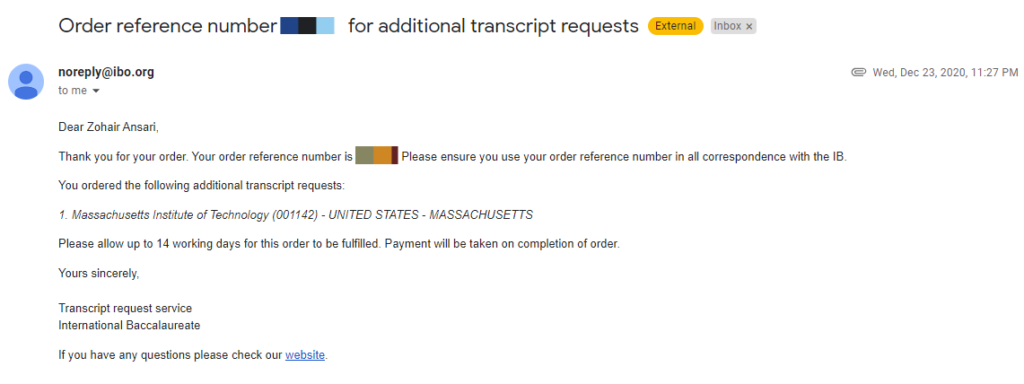
Here is one of the order receipts I received from IB when I placed my electronic transcript order for MIT:
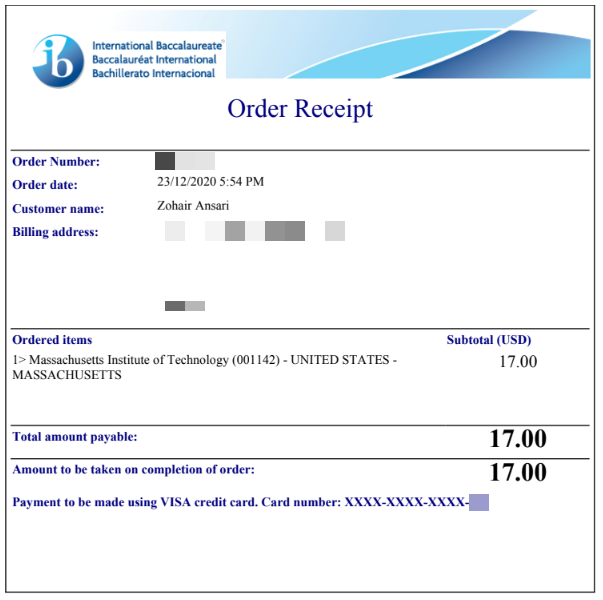
Sending official transcripts to universities was a huge expense for me and one that I didn’t expect, so be sure you know how to request an official transcript for US universities from your exam-conducting institution and how much it would cost you.
I didn’t know how I could avoid this expense at that time. However, as a financial-aid-seeking applicant, there was an alternative path that could’ve helped me reduce this payment a lot or at least a little bit. I didn’t know it then. Let me tell you 😉
If you are on a tight budget and sending either an electronic transcript or paper transcript from your test-conducting organization to several US Universities can cost you a lot of money and can be a financial burden for you and your family, you can request your universities to accept the electronic version of the transcript via email from your school counselor or school head.
Most universities that offer full financial aid to all admitted students will consider your request and most likely approve it; however, some may not, and that’s okay because you’d save a lot of money even if a few of them approve your request.
Score Sending Fees
I couldn’t use this tactic to reduce my transcript sending fee, but I definitely used it to reduce my next expense: sending test scores to US Universities.
Sending English Language Proficiency Test Scores
After you take an English language proficiency test, you must send its scores to the universities that require them. Every university has a different set of requirements for proof of English proficiency.
For example, some say that if you’ve studied in a high school with English as the primary language of instruction, you don’t need to submit your IELTS or TOEFL scores, while others say that if you are a non-native English speaker, you must submit English test scores no matter what.
English proficiency isn’t a factor for admission into universities. It’s just to check whether you’re proficient and fluent enough to handle the rigor of the program and that English communication won’t hinder your success. I knew this back then, but what confused me was the different English requirements for the universities I was applying to 😖
Harvard said it didn’t require an English test, while MIT recommended it. Princeton, on the other hand, placed conditions on its exemption. So I wrote a separate email to each of the twelve admission teams of the US universities and asked for clarification on the English requirements.
In the email, I mentioned my English background, my exam scores and asked whether or not I was required to send my English Proficiency Test scores.
If you’re curious, here is the email I wrote:
Dear Admissions Team,
Hope this email finds you well,
I am Zohair Ansari, a non-native English speaker and an IB DP graduate, currently residing in India. I have completed my entire secondary education in India and at a school where English was and is the primary language of instruction and documentation.
Also, I have successfully completed the IB PYP, IB MYP, Cambridge IGCSE and IB DP with English as the medium of instruction and examination.
Additionally, in my IB DP May 2020 Examination, I have secured a 7 in English B (HL).
However, I want to inquire whether my background will allow the requirement of English Proficiency Exams to be waived off or will I still have to submit an English Proficiency Test as a proof of language proficiency?
Hope to hear from you soon.
Thank You For Your Help and Support,
Zohair
I sent this same email to all the universities. Apart from Brown, Cornell, Dartmouth, and Yale, all the universities directly or indirectly told me that I wouldn’t need to submit my English proficiency test scores based on the background I mentioned in the email.
Here is a response from Amherst College, granting me an English Proficiency Requirement Exemption 👇
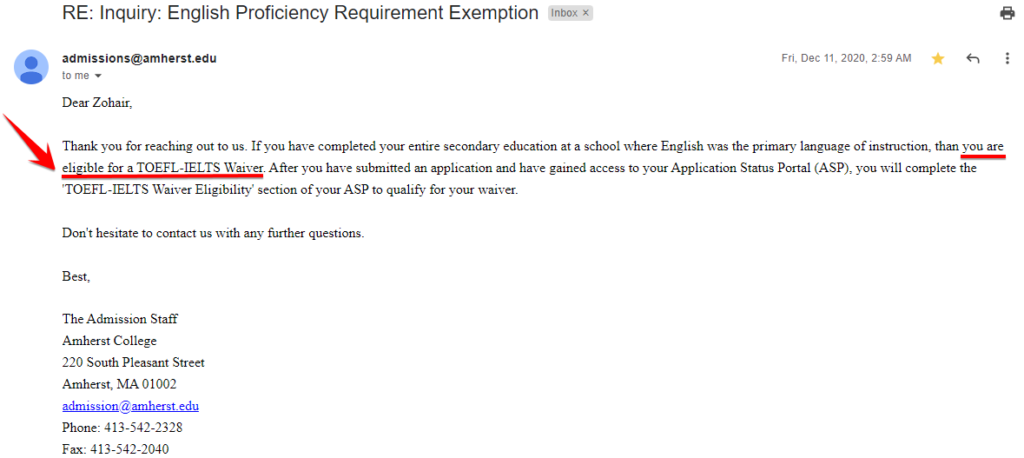
My school background and educational background allowed them to exempt me from the requirement, but maybe you might not receive an exemption based on your background. So don’t think that because I got an exemption as an international student, you too are exempted. That’s not the case. Everybody has a unique language background. So be sure to share your background in the email before asking for an exemption ✒
My next job was to send my IELTS results to four US Universities that required them. The process of sending IELTS results is quite simple and cheap compared to sending SAT or ACT results, which I’ll talk about in a minute.
If you don’t know, the IELTS score report is called the Additional Test Report Form (ATRF), and on the IELTS Candidate Portal, you can request up to five electronic ATRFs for five universities free of charge. After five free electronic ATRFs, you will be charged a fee of ₹250 or ~$3.2 for each additional ATRF you request.
You can also send a physical copy of your ATRF, but it will cost you ₹400 or ~$5.2 per request for ordinary post and ₹1500 or ~$19.2 for each courier request. It’s really convenient and cheap to send IELTS results electronically; however, some US universities might not accept your IELTS result electronically, so you’ll need to send it to them by post or courier. Therefore, before you place an ATRF request, make sure you have checked with the universities and particular departments about the format of IELTS results they accept.
Fortunately, the four universities that required IELTS results from me were all accepting IELTS results electronically, so I didn’t have to worry about the physical delivery of my IELTS results 🚚
In India, the process for requesting ATRF and sending IELTS results is quite smooth today, but in 2020 it wasn’t that smooth, especially if you registered through the British Council. There were no official tutorials or guides about sending results to global institutions electronically. Overall, It wasn’t very clear, but I somehow figured it out through online resources.
I filled out an online ATRF request form, which was available on British Council’s website. Along with the four US Universities that had requested the IELTS results, I added the University of Toronto because they also required the IELTS results.
At that time, the fee for one ATRF request was ₹200 or ~$2.6. So it cost me ₹1000 or ~$12.8 to send my IELTS results to five universities.
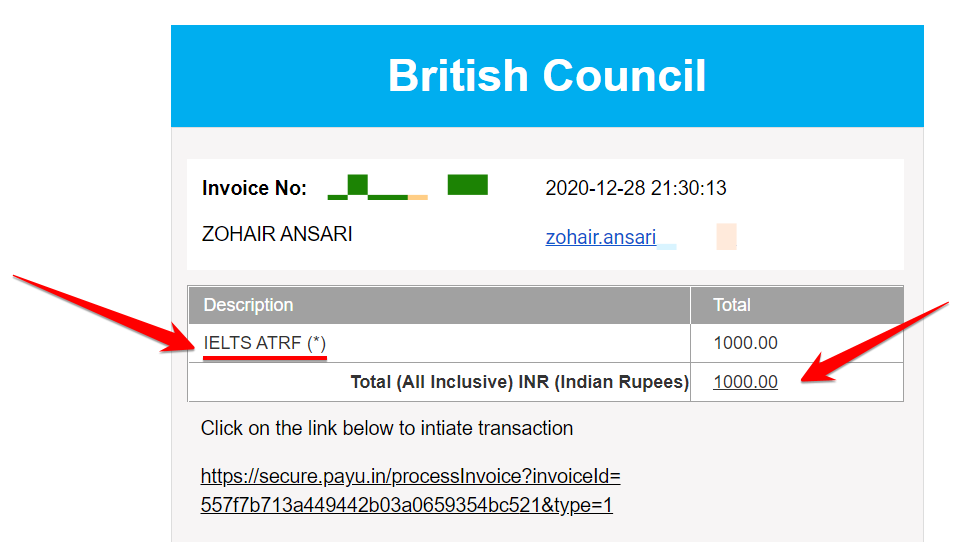
If you exclude the University of Toronto, a Canadian University, the expense was ₹800 or ~$10.
If the six universities that required my English test scores did not exempt me, I would’ve paid an extra ₹1200 or ~$15 to send my IELTS results. Now, if you are an Indian resident, you might know that British Council no longer conducts the IELTS test in India. So your only option is to take your IELTS test with IDP and send its results through IDP’s Candidate Dashboard, which has a smoother process, in my experience.
Before moving on, an important note for you is that if
- You have good IELTS scores ✔
- Your universities recommend that you submit the English test results ✔
- You have the financial backup to bear its expenses ✔
I highly recommend you send your test scores to these universities because it will help your application as the universities will have another metric to analyze your capabilities. So if you’re meeting the three conditions above, you shouldn’t have any reason not to send your good English test scores.
It’s worth spending a few dollars (~a few thousand Rupees) to present a better profile to the admissions committee, and the same is true for the standardized test results. Also, my situation was quite different because I had neither a great IELTS score nor enough financial backup to send my scores to all the universities, so I had to take the route I had just shared. Your situation might be very different, so take calculated steps accordingly 🐾
Sending Standardized Test Scores
Apart from sending English test scores, standardized test scores also need to be sent to US Universities. Of course, as most US Universities are test-optional with the standardized testing requirement, you can choose to send or not send your results to these universities.
If you’ve taken a standardized test, be it the SAT or the ACT, and you want to send its scores to the universities you’ve applied to, the College Board and the ACT offer you the opportunity to send the score reports to four institutions, free of charge. However, after four free reports, you will be charged a fee for each additional score report you send.
Now, the time you have available to use your four free score reports varies for the SAT and ACT but for both of them, you can only send free reports before the results are released, which means your score will be sent even before you know how you performed.
However, you can also send your score reports after seeing your results for a fee of $12 per report for the SAT and $16 per report for the ACT. This score sending fee can’t be waived except if you get an SAT or ACT fee waiver. In that case, you can send your score reports to as many colleges as you like for absolutely no charge, but as I said before, that’s only for U.S. residents.
Hence, international applicants residing in other countries have no option but to pay the score sending fee for each institution if they wish to send their standardized test scores.
As for me, I decided not to submit my SAT Scores, neither for the SAT Subject Tests nor for the SAT General, because I didn’t have excellent test scores, and top US universities went test-optional for the fall of 2021. So that’s why I had no cost associated with sending Standardized test scores to universities.
However, I’d recommend everyone to take a standardized test and submit their scores to US universities because it helps you improve your profile in a competitive applicant pool. Unfortunately, I realized its importance only when it was too late.
Again, I will reinforce what I stated earlier: my financial condition was quite weak, and applying to these many universities was really challenging, so I had to figure out ways to spend as little as possible while presenting a good profile. But, your situation and circumstances might be different, and if they are financially strong, do use all opportunities to improve your profile and candidature.
Financial Aid Application Fees
After you’ve completed the application requirements for all the US Universities, it’s time to fill out the financial aid application, assuming you’re applying for financial aid. The irony of the US financial aid application process is that you need to pay money to ask for money. Meaning, once you complete the financial aid application, i.e., the CSS Profile, and want to send it to the universities that require it, you’ll be charged a fee for each institution by the College Board.
What’s the fee for sending the CSS Profile?
It’s $25 for the first institution and $16 for each additional institution you add. The 25-dollar charge includes the application fee of $9 and a college reporting fee of $16. College Board charges the application fee only once regardless of the number of universities you send your CSS Profile to and adds the college reporting fee on top depending on the number of schools you add to the sending list.
If you are a domestic applicant, you have the option of Federal aid provided by the US Government, which you can apply for by filling out the FAFSA. It’s free and won’t cost you any money unless you’re seeking help from a third party to fill it. Apart from Federal aid, you also have the option of Institutional assistance provided by different US Universities, which you can apply for through the CSS Profile.
If your annual family income is less than $100,000, you can send your CSS Profile for free to as many institutions as you like through College Board’s official CSS Profile Fee Waiver. However, if your income exceeds that threshold, you’ll be charged $25 for the first school and $16 for any additional submissions. Even though you are charged a fee above this threshold, you can get it waived too through the institutional CSS Profile fee waiver, which I’ll discuss in a minute.
But before that, what about international students?
The policies for international students are a bit different, and opportunities are fewer compared to domestic students. In short, you are neither eligible for Federal Aid by the US Government nor for the College Board’s official CSS Profile fee waiver. Hence, the only way to waive your CSS Profile fee is through Institutional CSS Profile fee waivers which are fee waivers that are provided by specific universities to students in need.
It’s not easy to apply for these fee waivers, and the process of requesting them differs for different universities. That’s why I’ve created a dedicated post on how to apply for the institutional CSS Profile fee waivers, their eligibility criteria, and the step-by-step process I used to get them.
If you want to know more, I highly recommend you check that out by clicking the link below. It has benefited many students, and I’m sure it will be worth the time no matter whether you’re a domestic or international student.
👉 How To Get The CSS Profile Fee Waiver? (Everything You Need to Know)
When I applied for the institutional CSS Profile Fee Waiver at US institutions, four of them (including Amherst College, Cornell University, Columbia University, and New York University Abu Dhabi) instantly approved my request and waived the CSS Profile fee based on my family’s financial background.
Here is my first Payment Receipt for the CSS Profile 👇
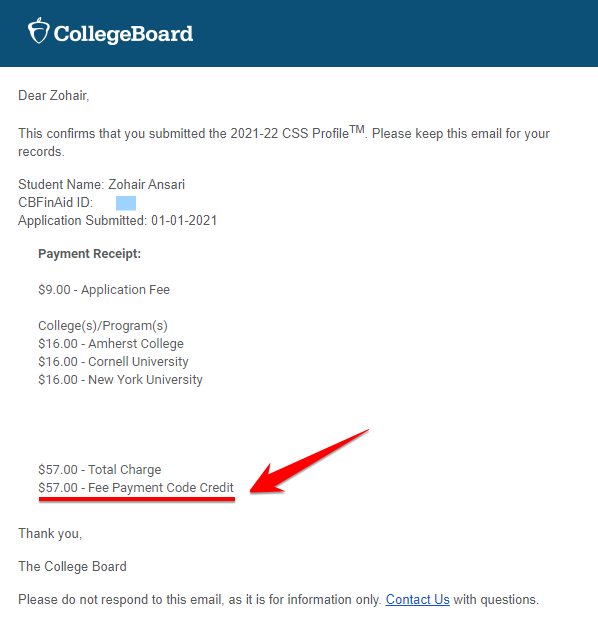
As you can see, the CSS Profile fee waiver codes I received from these universities completely waived the cost of the application submission.
Here is my second Payment receipt for the CSS Profile for Columbia University. Notice how College Board did not include the Application fee in this payment (because it’s a one-time payment that got waived through the fee waiver codes I received above) 👇
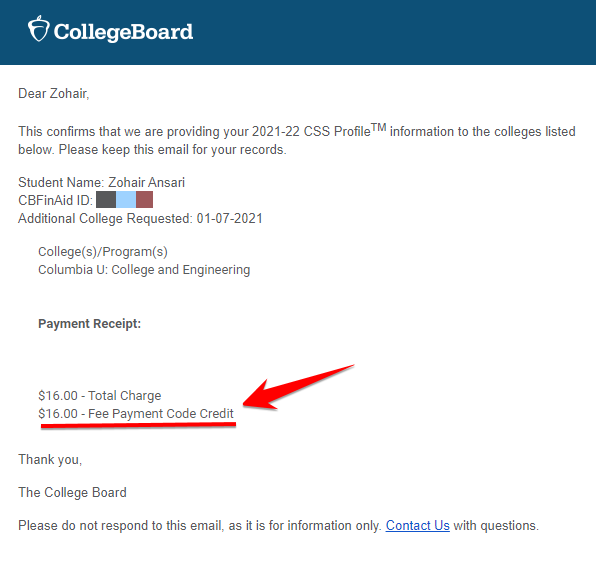
In no time, I was able to send my CSS Profile to these four institutions, and that too, free of charge. With just these four fee waivers, I was able to save 25+16+16+16 = $73, thanks to the generosity of Amherst, Cornell, Columbia, and NYUAD 🤗
Yale University and Dartmouth College also approved my CSS Profile fee waiver request by telling me to fill out an alternative financial aid form similar to the CSS Profile, called ISFAA, and submit it via email.
I tried filling it out electronically, but it wasn’t feasible, so I decided to get a hard copy of these forms. There were ten pages, and it cost ₹10 per page for a colored printout in my locality. However, my school principal helped me with that, and I got ₹100 worth of colored printouts for free.
Harvard University also offered a CSS Profile fee waiver by asking me to fill out an alternative financial aid application form on their website; however, I couldn’t use that due to the lack of time. So I decided to pay Harvard’s CSS Profile fee along with the fee for four other US universities that didn’t provide me a CSS Profile fee waiver. These include Stanford University, Massachusetts Institute of Technology (MIT), University of Pennsylvania, and Brown University.
Sending CSS Profile to these five universities cost $80 or ~₹6,250. It should’ve cost $89; however, College Board somehow waived the application fee and just charged the College Reporting fee for five universities.
Here is the Payment Receipt for the CSS Profile from College Board for the five Universities mentioned above. It is my third CSS Profile fee payment receipt and this time it includes the amount paid via Credit card because the universities did not provide me the waiver and I had to pay it from my pocket. Have a look 👇
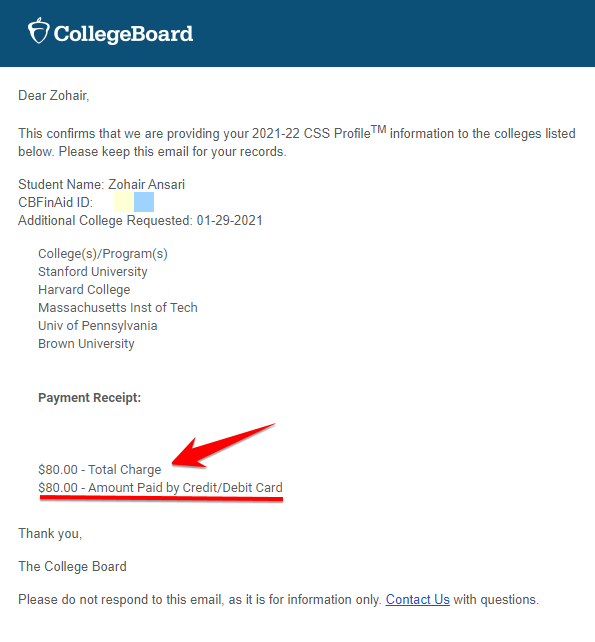
Why College Board charged $80 instead of $89 when sending my CSS profile for the third time?
As I said, the College Board charges the Application Fee only once, and for me, that one-time application fee got waived using the three CSS Profile Fee Waiver codes I used to submit CSS Profile to Cornell, NYUAD, and Amherst. So when I sent my additional CSS Profile requests for other colleges, College Board didn’t charge the application fee because it is meant to be charged only once.
I hope this makes sense 😅
Again, if you want to know more about fee waiver codes, I’ve explained it in my ‘CSS profile fee waiver’ post, so check it out once you’ve read this post to understand all the options.
What about Princeton University?
Interestingly, Princeton University doesn’t require the CSS Profile. Instead, it has its own financial aid application, Princeton Financial Aid Application (PFAA), on its portal, which is free for both domestic and international students. Hence, I could fill it out and submit it without any costs.
Overall, I saved a total of $105 or ~₹8,200 using the institutional CSS Profile fee waivers from six universities, and I spent $80 or ~₹6,250 for submitting CSS Profile to five universities that couldn’t offer the fee waiver except for Harvard where I myself couldn’t use their fee waiver.
Apart from all of this, I got many printouts of my family’s financial documentation to submit on College Board’s IDOC. If you don’t know, the College Board’s Institutional Documentation Service is called IDOC, and it collects financial documents from students and submits them to colleges on their behalf after a student is done submitting their CSS Profile.
They collect this documentation to verify the information you filled in on the CSS Profile. I’m not going to get deep into what documentation I submitted. Still, every university had different requirements, and I had to print and fill out many forms for the each university’s specific needs 🖨
These forms included the student’s non-tax filer, mother’s non-tax filer, cover sheet, etc., and were mainly requested by Harvard, Princeton, and Columbia University. It might’ve cost around ₹80 for these printouts, but since we are including ALL the costs associated with the application process, it wouldn’t be right to neglect this expense.
Also, US universities will definitely ask for your parents’ income tax returns, and obtaining it from the income tax department or your tax consultant can come with a cost depending on your country.
Total Cost
So, the most awaited question 🥁
How much money did it cost me to apply to twelve US Universities, from test prep to sending financial aid applications?
It is ₹63,766 or ~$816.
To summarize the expenses in a table, here is the breakdown of all the costs that the US College application process had for me during the fall of 2021. Remember all the twelve universities I applied to grant full financial aid to international students, and here is the cost of applying to them.
| S.No | Payment For | Amount |
| 1 | Four SAT Preparation Books 1. The Official SAT Subject Test in Mathematics Level 2 Study Guide ₹599/- 2. SAT Subject Test: Math Level 2 with Online Tests (Barron’s Test Prep) ₹1680/- 3. The Official SAT Subject Test in Physics Study Guide ₹1056/- 4. SAT Subject Test Physics with Online Test (Barron’s Test Prep) ₹1341/- | ₹4,676 or ~$60 |
| 2 | SAT General Eight Official Practice Tests Printout | ₹500 or ~$6.50 |
| 3 | SAT General Test Registration Fee | $98.50 or ~₹7,700 |
| 4 | SAT Subject Tests Registration Fee | $119 or ~₹9,300 |
| 5 | IELTS Exam Registration Fee | ₹13,250 or ~$170 |
| 6 | IELTS Coaching Classes Fee | ₹6,500 or ~$83 |
| 7 | IB Transcript Requests for Eleven Universities ($17 per request) | $187 or ~₹14,610 |
| 8 | Sending IELTS Scores to Four Universities | ₹800 or ~$10 |
| 9 | Sending CSS Profile to Four Universities | $80 or ~₹6,250 |
| 10 | Printout of two ISFAA Forms | ₹100 or ~$1.3 |
| 11 | Printout of financial aid application forms for IDOC | ₹80 or ~$1 |
| TOTAL COST | ~ ₹63,766 or $816 |
Some students like to take Essay Editing services, while others seek help from famous college consultants, I didn’t use those services, and I won’t stop you from utilizing those services. But, as I stated in the beginning, the cost for you will vary depending on a number of factors. It may be higher than this, or it might be lower than this. So look at this table and create an expenses table for yourself where you write all the costs you personally have to go through to avoid any unpleasant surprises while applying.
The value of most currencies continuously changes against the US Dollar. For this post, I’ve used $1 = ₹78.14 as the conversion rate between US Dollar and Indian Rupee. For the US application process, some payments were made in Indian Rupees while others were made in US Dollars; hence, the total cost is not 100% accurate. So when you apply for US Universities now, do expect minor variations in these payments with respect to your home currency.
Basically, this is how much I spend applying to US Universities 😗
Just so you know, I didn’t just apply to US Universities. I also applied to Turkish Universities, Canadian Universities, and some international scholarship programs. And they had their expenses too, because, unlike top US Universities, they are not much flexible with their application process and are not generous enough to offer fee waivers during the process.
As this post is about US Universities, I didn’t include any costs I had to bear from the application process of universities from other countries. Of course, you may need more money if you are thinking about applying to other countries.
Total Saved
Now, if you’re curious, how much money I saved in the whole US College Application Process. Here is a table that breaks it down:
| S.No | Saved For | Amount |
| 1 | Application Fees to US Universities (Common App Fee Waiver & MIT Application Fee Waiver) | $930 or ~₹72,700 |
| 2 | Sending IELTS Results to Universities (Exemption Request from 6 Universities) | ₹1,200 or ~$15 |
| 3 | Sending CSS Profile to Universities (4 CSS Profile Fee Waiver Codes & 2 ISFAA Forms) | $105 or ~₹8,200 |
| TOTAL SAVED | ~ ₹82,100 or $1,050 |
As you can see, I saved a total of ₹82,100 or $1,050. Overall, I saved more money than I spent in the US College Application Process.
On a side note, you’d be shocked to know that apart from the expense of IELTS Classes, my School Principal bore all the costs on my behalf because he wanted me to realize my dream of studying abroad at a top university. He did a lot for me, and it’s rare to find generous and supportive mentors like him in today’s times.
The ‘Expenses’ table shows that for a low-to-middle income family, even applying in the US is a good enough barrier. Still, we also learn from the ‘Savings’ table that Common App Fee Waiver has dramatically reduced this barrier.
If Common App didn’t provide its application fee waiver, it would’ve been financially impossible for me to apply to as many as eleven American universities then. So don’t forget to read my ‘Common App Fee Waiver‘ post if you want to know the step-by-step process to get the application fee waived for your universities.
The Right Attitude
Lastly, I’d say, “Yes, the US College Application process is expensive, but the application process in other countries is equally, if not more, expensive.”
If you apply to ten US Universities, you do have the option of the Common App Fee Waiver, but if you apply to ten Universities in the UK, Canada, or Australia, you won’t get fee waivers from most of them.
Moreover, US Universities, especially the top ones, are trying to reduce as many barriers as possible for students in need, even for international students. They are making their application process more flexible and adding alternatives to their application requirements to cover the needs of specific groups of students 👨🎓
Not to mention, after the admission and financial aid application process, you’ll be getting thousands of dollars of aid, most of which you won’t have to pay back. So in that sense, this $816 of application cost is nothing.
Therefore, I’d say that please don’t get too hung up on reducing your application costs or trying to save as much as possible. Yes, the process is a lot about the cost, but it’s also about your application and profile. So use your valuable time and focus more on making your application the best it can be from your end.
That’s why I’ve created this post to share all the costs with you so you can prepare your game plan for the expenses beforehand and complete the process smoothly 🤸♂️
Learn More
If you don’t know, I got rejected from all the Ivy League schools I applied to because I made some big mistakes during the process. If you want to know what those mistakes are and how to avoid them, you should definitely consider reading that post next.
👉 5 Mistakes That Got Me Rejected from All the Top US Universities (Must Avoid Them)
But before that, share this post with your friends who are going through this process, so this post will also help them.
Do comment down in case you have any questions or remarks 💬
See you in the next one.
Good Bye, and Take care 🙋♂️



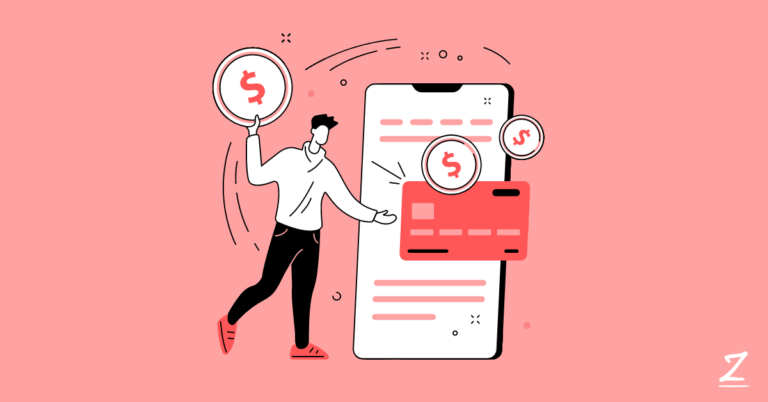



Hey There!
Myself Anand Singh and I’m a sat aspirant. I am one of your YouTube subscribers , and learns a lot from your content. I am quite confused with my common app essay like on which prompt to write about. I have been the band commander of school for 3 years, is it a topic which will have a good impression of mine on the reader or should I write about the time I was in short of depression and how I overcome it.
Please do give your feedback. I’m looking forward for your reply.
Cheers
Hey Anand,
Thanks for your comment.
I don’t know much about how these experiences impacted you and how you are framing them in your application as a whole. I suggest you focus on an experience that impacted you the most, is close to your heart and changed you the most as a person. For me, I had a lot of extracurricular activities but I chose to write on my background and how it shaped me because that’s what impacted my life the most. So a general rule: brainstorm a couple of ideas, go deep into them and see which one impacted you the most.
Good impression depends on how you tell the story to the reader, a lifechanging experience may not impress the reader if you don’t write it creatively, so it depends on how you write about it.
I hope this helps.